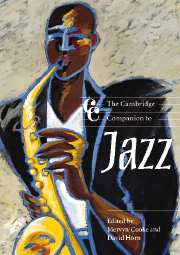Book contents
- Frontmatter
- The word jazz
- Part One Jazz times
- Part Two Jazz practices
- 5 Jazz as musical practice
- 6 Jazz as cultural practice
- 7 Jazz improvisation
- 8 Spontaneity and organisation
- 9 Jazz among the classics, and the case of Duke Ellington
- Part Three Jazz changes
- Part Four Jazz soundings
- Part Five Jazz takes
- Notes
- Works cited
- Principal musicians cited
- Index
8 - Spontaneity and organisation
from Part Two - Jazz practices
Published online by Cambridge University Press: 28 September 2011
- Frontmatter
- The word jazz
- Part One Jazz times
- Part Two Jazz practices
- 5 Jazz as musical practice
- 6 Jazz as cultural practice
- 7 Jazz improvisation
- 8 Spontaneity and organisation
- 9 Jazz among the classics, and the case of Duke Ellington
- Part Three Jazz changes
- Part Four Jazz soundings
- Part Five Jazz takes
- Notes
- Works cited
- Principal musicians cited
- Index
Summary
‘Improvisation’, wrote Gunther Schuller in his groundbreaking study, Early Jazz, ‘is the heart and soul of jazz’ (1968, 58). Yet, as Bruce Johnson points out elsewhere (see Chapter 6), improvisation is only one of the distinctive elements of the music, and indeed Schuller immediately qualifies his assertion by pointing out that improvisation is also an essential ingredient of other folk and popular musical traditions. Even more to the point, improvisation is not a major ingredient in many celebrated jazz recordings. Louis Armstrong's classic ‘Cornet Chop Suey’ of 1926 was copyrighted almost as recorded (and in the trumpeter's own hand) more than two years earlier (Gushee in Nettl and Russell 1998, 298–9). Duke Ellington's ‘Concerto for Cootie’ of 1940 was described as a ‘masterpiece’ by another pioneering analyst, André Hodeir, yet one of the characteristics of the piece is ‘the elimination of improvisation’ (Hodeir 1956, 77). As the recorded evidence shows, other renowned soloists can be heard to repeat familiar solos in all essential respects, and over considerable periods of time (Berliner 1994, 240). As Armstrong himself put it: ‘always, once you get a certain solo that fit in the tune, and that's it, you keep it. Only vary it two or three notes every time you play it’ (quoted by Gushee in Nettl and Russell 1998, 313). Across the stylistic spectrum, too, performances have been praised mainly because they achieve the elusive quality of ‘swing’ (see Keil 1995), or when melodies are simply embellished but where the player's instrumental tone – as on Clifford Brown with Strings (1955) – is judged to be particularly expressive. Only the pedantic, however, would disqualify these and many other pieces from acceptance as jazz on the grounds that they lack a substantially improvised component.
- Type
- Chapter
- Information
- The Cambridge Companion to Jazz , pp. 133 - 152Publisher: Cambridge University PressPrint publication year: 2003
- 6
- Cited by



